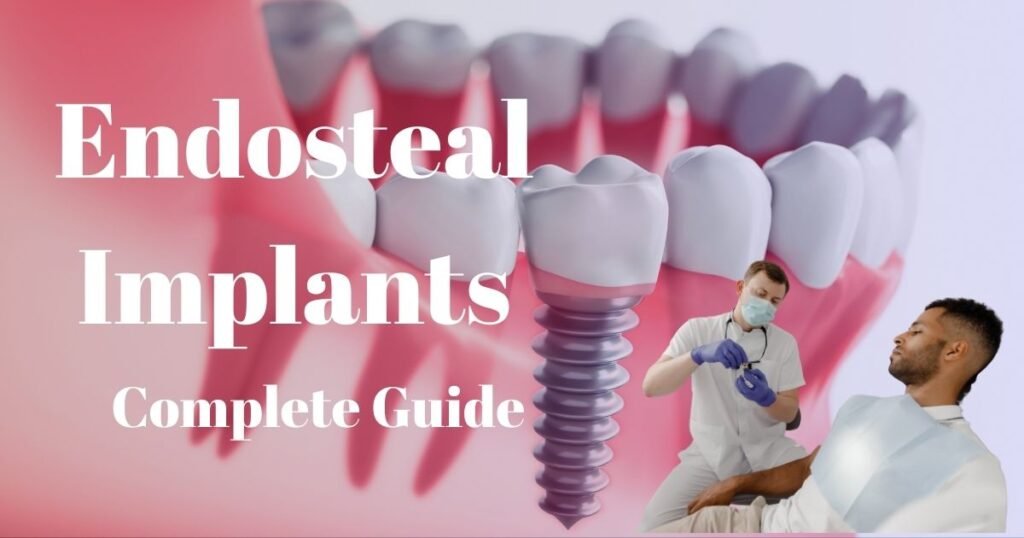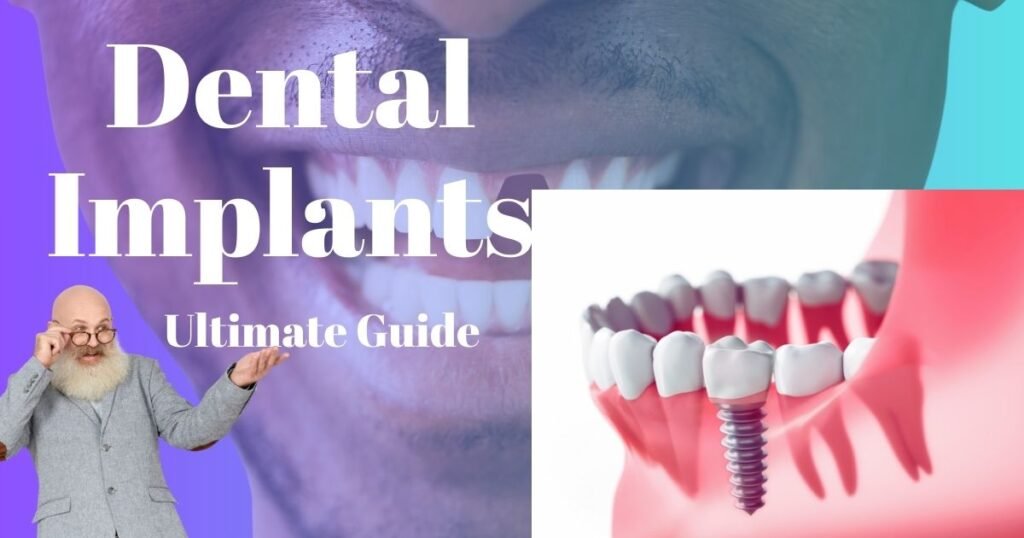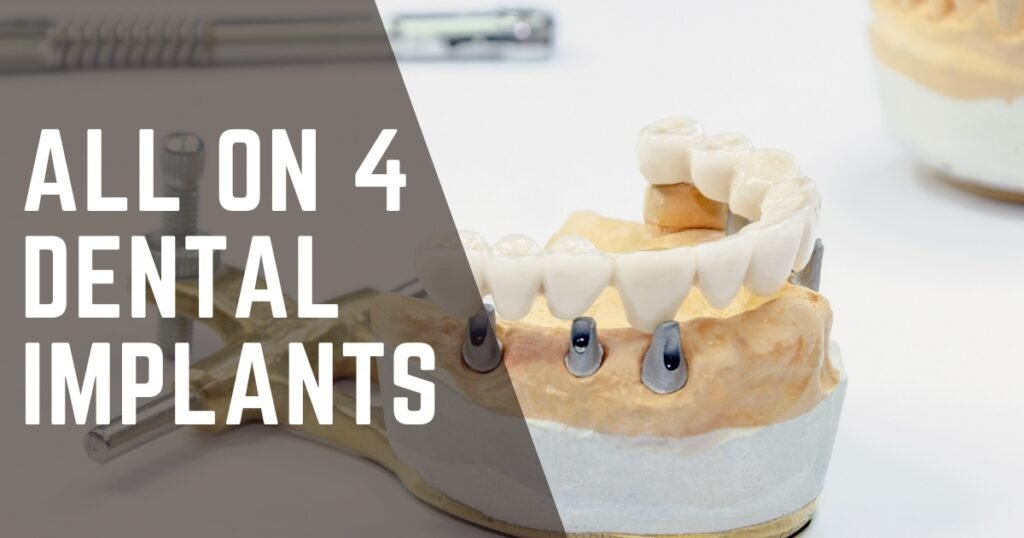What is an Endosteal Implant?
An endosteal implant is a type of dental implant designed to replace missing teeth. It is implanted in the jawbone and acts as an artificial tooth root to provide support for a denture, bridge, or crown. The implants are constructed of titanium, a biocompatible material that integrates with the jawbone in a phenomenon known as osseointegration.
Endosteal implant-supported teeth are stable and durable, and are the first choice of patients with good bone structure.
These are the most popular dental implants used, they provide a strong, natural-looking solution for missing teeth. This full guide will cover the process, advantages, cost, and recovery!
Types of Endosteal Implants
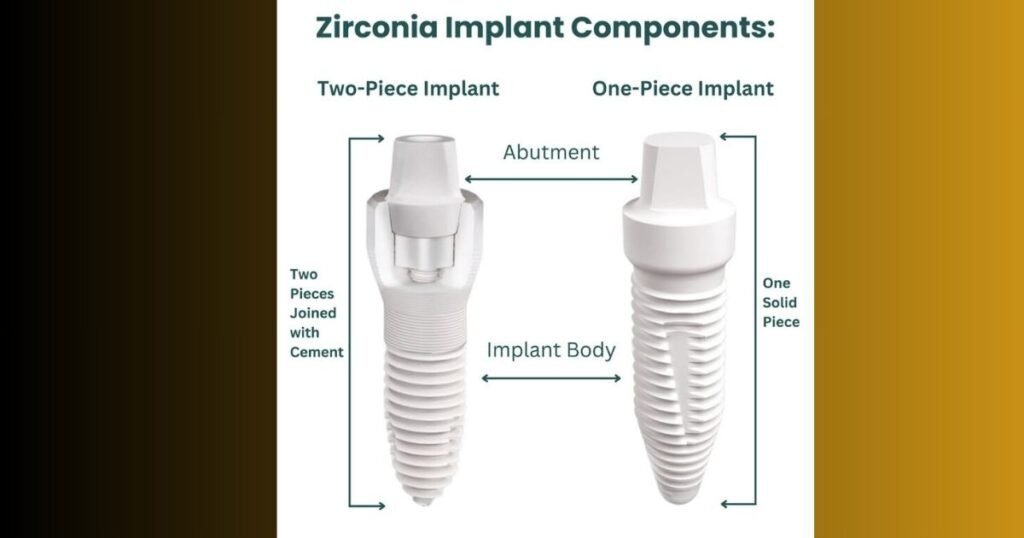
Three common types of endosteal implants are as follows:
1. Screw-Type Implants
These are the standard and they look like small screws. They are implanted directly into and fused with the jawbone, and offer strong support for false teeth.
2. Cylinder (Smooth) Implants
These implants were just smooth, they do not have any threads. For added stability, some may need more bone grafting.
3. Blade Implants
They are narrow, flat implants for people with a narrow jawbone. They provide a variety of sites to attach artificial teeth.
Who is an Ideal Candidate for an Endosteal Implant?
Endosteal implants aren’t for everyone. The following are eligibility criteria: Patients must:
- Healthy quantity of jawbone – The implant requires an adequate level of bone support.
- Good Gums – No current gum disease or infection.
- Overall good health — Conditions like uncontrolled diabetes can affect healing.
- Dedication to oral health – Taking good care of your smile is key to long-term health.
When the volume of bone is not sufficient, bone grafting can be considered as a prerequisite for the implant procedure.
Procedure for Getting an Endosteal Implant
The process of getting an endosteal implant involves multiple stages:
1. Consultation and Evaluation
A dentist or oral surgeon examines the patient’s oral health, takes X-rays or 3D scans, and determines if they are a good candidate for implants.

2. Preparatory Procedures (If Needed)

If the patient has bone loss, a bone graft may be required to strengthen the jawbone before implantation. This process can take several months for healing.
3. Implant Surgery
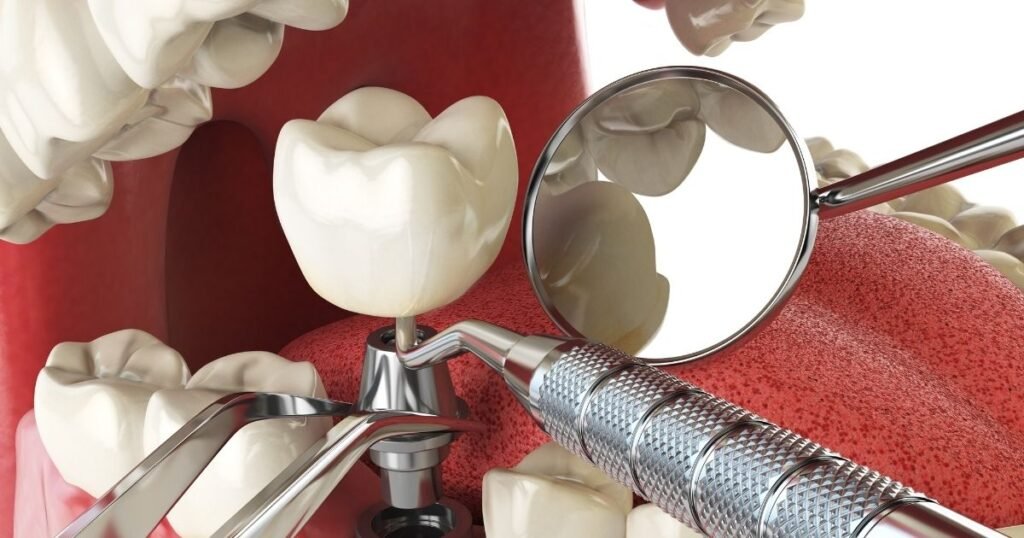
The dentist surgically places the titanium implant into the jawbone under local anesthesia or sedation. The gum tissue is stitched, and healing begins.
4. Osseointegration Period (3-6 Months)

Over several months, the implant fuses with the bone in a process called osseointegration. This ensures a strong foundation for the artificial tooth.
5. Abutment Placement
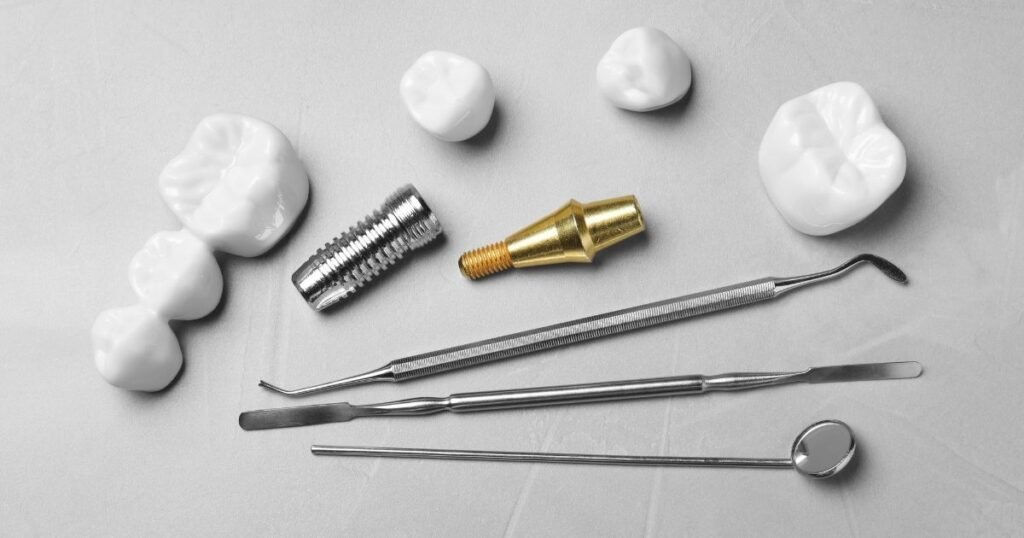
Once healing is complete, a small abutment is attached to the implant. This piece connects the implant to the final dental crown, bridge, or denture.
6. Placement of the Artificial Tooth

A custom-made dental crown, bridge, or denture is secured onto the abutment, restoring the patient’s smile and bite function.
Benefits of Endosteal Implants
1. Natural Look and Feel
Endosteal implants closely resemble natural teeth in appearance and function, improving both aesthetics and speech.
2. Long-Lasting Solution
With proper care, endosteal implants can last 20 years or more, making them a durable option for tooth replacement.
3. Improved Bone Health
Implants stimulate the jawbone, preventing bone loss that typically occurs after tooth loss.
4. High Success Rate
Endosteal implants have a 95-98% success rate, making them a reliable treatment option.
5. No Damage to Adjacent Teeth
Unlike bridges, implants do not require grinding down neighboring teeth for support.
Potential Risks and Complications

While endosteal implants are generally safe, some risks include:
- Infection – Poor oral hygiene can lead to infections around the implant.
- Implant failure – In rare cases, the implant may not fuse properly with the jawbone.
- Nerve damage – Improper placement may cause temporary or permanent nerve issues.
- Sinus problems – Implants in the upper jaw may protrude into sinus cavities if not placed correctly.
Recovery and Aftercare

Immediate Post-Surgery Care
- Swelling and mild discomfort are common for a few days.
- Pain medications and antibiotics may be prescribed.
- A soft diet is recommended during the healing phase.
Long-Term Maintenance
- Brush and floss twice daily to prevent infections.
- Regular dental check-ups ensure implant health.
- Avoid smoking and excessive alcohol consumption, as they can weaken implant stability.
Cost of Endosteal Implants in the USA

The cost of an endosteal implant varies depending on location, the dentist’s experience, and additional procedures required. Here is an estimated cost breakdown:
| Procedure | Average Cost (Per Tooth) |
|---|---|
| Initial Consultation | $50 – $200 |
| Bone Graft (If Needed) | $250 – $3,000 |
| Implant Surgery | $1,500 – $3,000 |
| Abutment Placement | $300 – $500 |
| Crown Placement | $1,000 – $3,000 |
| Total Cost | $3,000 – $7,000+ |
Most dental insurance plans cover part of the procedure, but many classify implants as a cosmetic treatment, limiting coverage. Financing options like CareCredit and dental savings plans can help reduce costs.
Alternatives to Endosteal Implants
For patients who are not candidates for endosteal implants, other options include:
- Subperiosteal Implants – Placed on top of the jawbone under the gum tissue, suitable for patients with significant bone loss.
- Dental Bridges – Non-surgical option that relies on neighboring teeth for support.
- Removable Dentures – Cost-effective, but less stable than implants.
Are You a Candidate for Endosteal Implants? – Take the 1-Minute Assessment
Benefits & Considerations
- Natural Look & Feel: Feels just like real teeth.
- Long-Term Durability: Can last 20+ years with proper care.
- Protects Jawbone: Prevents bone loss and supports facial structure.
- Stable Foundation: No shifting or movement like dentures.
- Improved Oral Health: No damage to adjacent teeth.
Are Endosteal Implants Right for You?
Answer a few questions to evaluate your potential suitability.
Conclusion
Endosteal implants are a gold-standard solution for tooth replacement, offering durability, functionality, and aesthetic appeal. While the procedure requires time and investment, the benefits of improved oral health and confidence make it worthwhile. If you’re considering an implant, consult a qualified dentist to determine the best treatment plan based on your needs.
FAQs on Endosteal Dental Implants
What is an endosteal implant?
An endosteal implant is a type of dental implant surgically placed into the jawbone to serve as an artificial tooth root. It provides a stable foundation for a dental crown, bridge, or denture, offering a permanent solution for missing teeth.
How is an endosteal implant different from a subperiosteal implant?
An endosteal dental implant is inserted directly into the jawbone, while a subperiosteal implant is placed on top of the jawbone beneath the gum tissue. Endosteal implants are more commonly used because they offer greater stability and durability.
Who is a good candidate for an endosteal implant?
A good candidate for an endosteal implant should have:
Sufficient jawbone density to support the implant
Healthy gums without periodontal disease
Good overall health for proper healing
Commitment to oral hygiene and regular dental visitsHow long does the endosteal dental implant procedure take?
The procedure typically takes 3-6 months in multiple stages:
Initial consultation and X-rays
Implant placement surgery
Osseointegration (3-6 months) for the implant to fuse with the bone
Abutment and crown placementDoes getting an endosteal implant hurt?
The surgery is performed under local anesthesia or sedation, so there is minimal discomfort during the procedure. Mild pain and swelling may occur after surgery, which can be managed with pain relievers and proper aftercare.
Are endosteal implants covered by insurance?
Many dental insurance plans classify implants as a cosmetic procedure, offering limited or no coverage. Some plans may cover part of the procedure if it’s medically necessary. Patients can explore financing options or dental discount plans to reduce costs.
What is osseointegration, and why is it important?
Osseointegration is the process where the titanium implant fuses with the jawbone. This step is crucial for implant stability, ensuring the implant functions like a natural tooth root and prevents bone loss.
How long do endosteal Dental implants last?
With proper care, endosteal implants can last 20+ years or even a lifetime. Regular brushing, flossing, and professional cleanings help maintain implant health.
Can I get an endosteal implant if I have bone loss?
If a patient has insufficient jawbone, they may need a bone graft before receiving an endosteal implant. This procedure strengthens the bone and increases the chances of implant success.
What are the risks of endosteal implants?
While endosteal implants have a high success rate (95-98%), some risks include:
Infection around the implant site
Implant failure due to poor osseointegration
Nerve damage can occur if placed incorrectly
Sinus issues if the implant is too close to the sinus cavitiesHow do I care for my endosteal implant?
To ensure long-term success:
Brush and floss twice daily
Use an antibacterial mouthwash
Avoid smoking and excessive alcohol use
Visit the dentist regularly for check-ups and cleaningsCan an endosteal implant be removed?
In rare cases, an implant may need to be removed due to infection, implant failure, or complications. If removal is necessary, a bone graft may be required before placing a new implant.
Are there alternatives to endosteal implants?
Yes, alternatives include:
Subperiosteal implants (for patients with bone loss)
Dental bridges (a non-surgical option)
Removable dentures (less expensive but less stable)How soon can I eat after getting an endosteal implant?
Patients can eat soft foods 24 hours after surgery. Hard, crunchy, and sticky foods should be avoided for at least 1-2 weeks to prevent complications during healing.
Read More RELATED Articles-How to Get Dental Implants Covered by Medical Insurance: Insider Tips & Tricks!

Dr. Niraj Ghanghoriya is a passionate dental surgeon with over 12 years of experience in clinical dentistry. He completed his BDS from the prestigious Sri Aurobindo Institute of Dentistry in 2012 and specializes in painless root canals, smile makeovers, and preventive oral care. Known for his patient-first approach and clear communication, Dr. Ghanghoriya aims to make dental knowledge accessible to everyone. When he’s not in the clinic, he enjoys writing informative dental blogs to help people take better care of their oral health.

